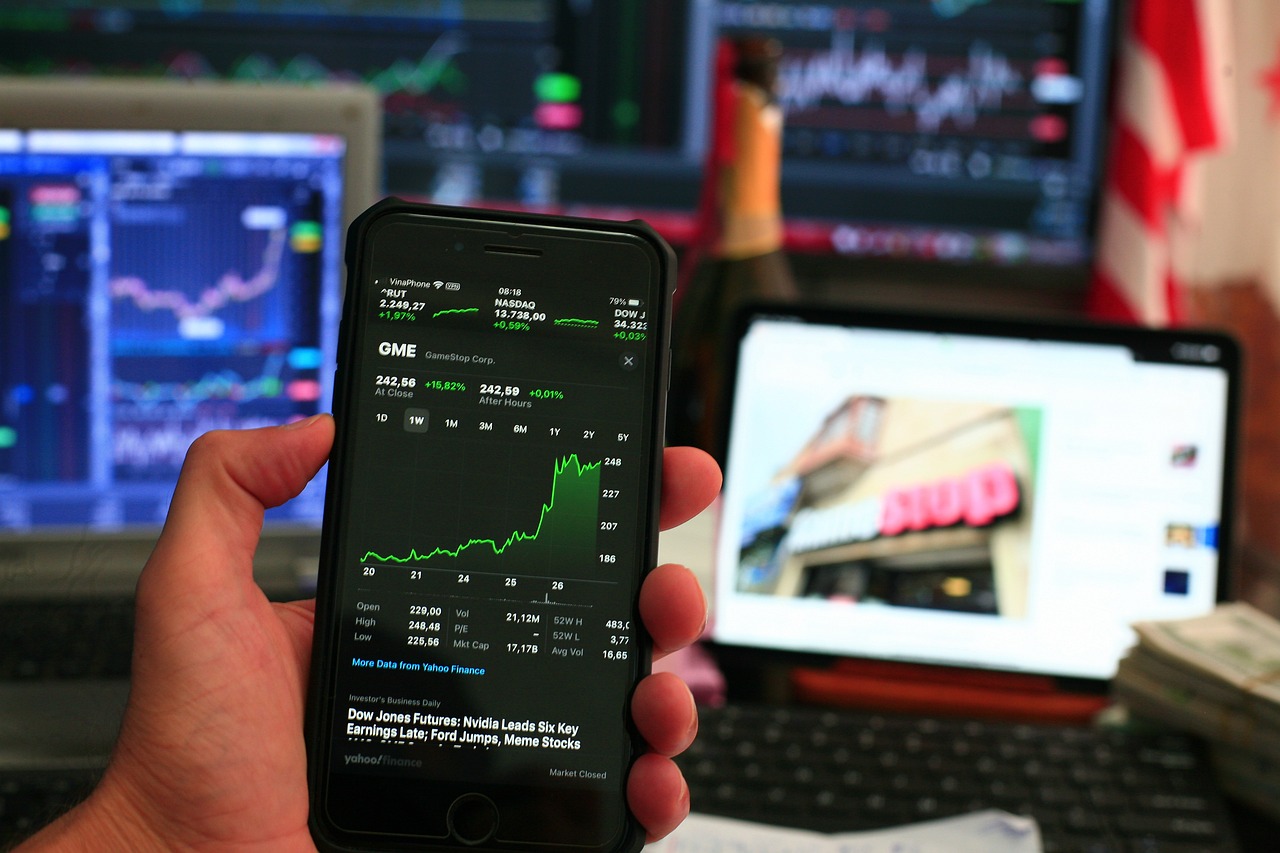Evaluating Market Performance During Major Economic Shifts
In today's fast-paced financial landscape, understanding how markets react during significant economic changes is crucial for investors and analysts alike. Major economic shifts, whether triggered by policy changes, technological breakthroughs, or unforeseen global events, can lead to dramatic fluctuations in market performance. This article delves into the intricacies of these shifts, analyzing trends in investor behavior and the broader implications for future investments. By equipping ourselves with knowledge about market dynamics during these turbulent times, we can make better-informed decisions and potentially capitalize on emerging opportunities.
Economic shifts can occur due to various factors, ranging from government policy changes to seismic technological advancements and global events like pandemics or geopolitical tensions. Grasping the essence of these shifts is not just an academic exercise; it’s a vital skill for anyone looking to navigate the financial markets effectively. When a significant economic change occurs, it often sends ripples through various sectors, affecting everything from stock prices to consumer behavior. For instance, when interest rates rise, borrowing becomes more expensive, which can slow down consumer spending and ultimately impact corporate profits. Hence, understanding these shifts is crucial for evaluating their impact on market performance.
Examining past market reactions during major economic shifts provides invaluable insights into how markets behave under pressure. Historical data reveals patterns that can help predict future market behavior in similar situations. For example, during the 2008 financial crisis, we witnessed a dramatic decline in stock prices, which was largely driven by a loss of confidence among investors. Similarly, the COVID-19 pandemic brought unprecedented volatility, with markets experiencing sharp declines followed by rapid recoveries in certain sectors. By analyzing these historical events, investors can better prepare for potential future downturns or recoveries.
Analyzing specific case studies of past economic shifts allows us to understand the direct correlation between economic changes and market performance. For instance, the 2008 financial crisis serves as a pivotal case study, showcasing how market performance can plummet during economic downturns. Understanding its causes and effects is essential for future preparedness. The financial meltdown was largely fueled by risky lending practices and a housing bubble that eventually burst, leading to widespread financial instability.
The 2008 financial crisis serves as a stark reminder of how quickly markets can turn. As banks collapsed and credit markets froze, investors panicked, leading to a massive sell-off in equities. This event not only reshaped regulatory frameworks but also changed investor behavior for years to come. Many investors learned the hard way the importance of risk management and diversification, which are now fundamental principles in investment strategies.
The COVID-19 pandemic drastically altered market dynamics, leading to unprecedented volatility. Initially, markets plummeted as lockdowns were instituted globally, and uncertainty gripped the economy. However, as governments rolled out stimulus packages and vaccination programs were implemented, markets rebounded sharply, particularly in tech and healthcare sectors. This section examines the immediate and long-term effects on various sectors and investment strategies, underscoring the need for adaptability in investment approaches.
Investor behavior often changes in response to economic shifts. Fear and uncertainty can lead to panic selling, while optimism can drive speculative buying. Understanding these behavioral patterns can help predict market movements and guide investment decisions during uncertain times. For instance, during the onset of the COVID-19 pandemic, many investors flocked to safe-haven assets like gold and government bonds, while tech stocks surged as remote work became the norm. Recognizing these trends can provide valuable insights into where the market might head next.
Identifying key economic indicators is vital for evaluating market performance. By tracking these metrics, investors can gauge the health of the economy and make informed decisions. Some important indicators to monitor include:
- Interest Rates: These play a significant role in influencing market performance. Analyzing their trends helps investors understand borrowing costs and their impact on economic activity.
- Unemployment Rates: Unemployment rates are critical indicators of economic health. Changes in employment levels can significantly affect consumer spending and overall market performance.
Developing effective strategies to navigate economic changes is essential for investors. The financial landscape is fraught with risks, but it also presents opportunities for those willing to adapt. This section outlines actionable approaches to mitigate risks and capitalize on opportunities during market fluctuations.
Diversification is a key strategy for managing risk during economic shifts. By spreading investments across different asset classes and sectors, investors can reduce the impact of poor performance in any single investment. For instance, a well-diversified portfolio might include a mix of stocks, bonds, and real estate, providing a buffer against market volatility.
Understanding the difference between long-term and short-term investing strategies can help investors make informed decisions during economic shifts. Long-term investing typically involves holding assets for several years, allowing for growth over time, while short-term investing focuses on quick gains. Each approach has its pros and cons, and the choice often depends on an investor's risk tolerance and financial goals.
1. What are the main factors that cause economic shifts?
Economic shifts can be caused by various factors including policy changes, technological advancements, global events, and market sentiment.
2. How can I prepare my investment strategy for economic shifts?
By diversifying your portfolio, keeping an eye on key economic indicators, and being adaptable to changing market conditions, you can better prepare for economic shifts.
3. What historical events should I study to understand market reactions?
Key events like the 2008 financial crisis and the COVID-19 pandemic offer valuable lessons on market behavior during economic downturns.

Understanding Economic Shifts
Economic shifts are like the tides of the ocean—sometimes they’re subtle, and other times they crash over us with a force we never saw coming. These shifts can arise from a myriad of factors, each playing a pivotal role in shaping market dynamics. For instance, significant policy changes, whether they be fiscal or monetary, can create ripples that affect everything from consumer confidence to investment strategies. Similarly, technological advancements can revolutionize entire industries overnight, leaving traditional business models scrambling to adapt. Global events, such as geopolitical tensions or natural disasters, can also trigger economic shifts that send shockwaves through the markets.
Understanding these shifts is not just about recognizing the signs; it’s about grasping the underlying mechanisms that drive them. For example, consider how a sudden increase in interest rates can lead to decreased consumer spending. When borrowing becomes more expensive, individuals and businesses tend to tighten their belts, which can slow down economic growth. On the flip side, a decrease in interest rates can stimulate spending and investment, thus invigorating the economy. It’s this intricate dance between various economic elements that investors must navigate to make informed decisions.
Moreover, economic shifts are often accompanied by changes in investor sentiment. During times of uncertainty, you might notice a flight to safety, where investors pull funds from riskier assets and flock to more stable investments like bonds or gold. This behavior can create significant volatility in the markets, making it crucial for investors to stay informed and agile. Understanding the broader economic landscape, including the factors that contribute to these shifts, can empower investors to anticipate changes and adjust their strategies accordingly.
In summary, economic shifts are complex phenomena influenced by a variety of factors. By keeping a keen eye on these shifts and understanding their implications, investors can better position themselves to weather the storms of the market. It’s not just about reacting to changes; it’s about being proactive and informed, which can make all the difference in achieving long-term financial success.

Historical Market Reactions
The financial markets are often seen as barometers of economic health, reacting dynamically to major economic shifts. Understanding how markets have historically responded during significant economic events can provide invaluable insights for investors today. One of the most striking aspects of market reactions is their tendency to reflect not just the current state of the economy but also the collective psychology of investors. When faced with uncertainty, fear can drive panic selling, while optimism can lead to exuberant buying, creating volatile swings in market performance.
Take, for example, the market's response to the 2008 financial crisis. This crisis was triggered by a complex interplay of factors, including the collapse of the housing bubble and the ensuing credit crunch. The stock market experienced a dramatic decline, with the S&P 500 losing over 50% of its value from its peak in 2007 to the trough in early 2009. This stark decline was not just a reflection of economic fundamentals but also a manifestation of investor sentiment, as panic spread through the financial system. The fear of a deep recession led many investors to flee equities, seeking safety in bonds and cash, which further exacerbated the downward spiral.
Similarly, the COVID-19 pandemic presented a unique case study in market reactions. When the pandemic first hit in early 2020, markets around the globe plummeted in a wave of uncertainty. The S&P 500 fell by approximately 34% in just over a month. However, as governments implemented stimulus measures and investors adapted to the new normal of remote work and online commerce, the markets rebounded astonishingly quickly. By August 2020, the S&P 500 had not only recovered its losses but reached new all-time highs. This rapid recovery highlighted the markets' ability to adapt to changing circumstances, driven by shifts in consumer behavior and technological advancements.
To illustrate these historical reactions more clearly, consider the following table that summarizes key economic shifts and their impacts on the stock market:
| Economic Shift | Market Reaction | Time Frame |
|---|---|---|
| 2008 Financial Crisis | Market decline of over 50% | 2007 - 2009 |
| COVID-19 Pandemic | Initial decline of 34%, followed by rapid recovery | March 2020 - August 2020 |
| Dot-com Bubble Burst | Market decline of 78% in tech stocks | 2000 - 2002 |
These historical examples not only emphasize the importance of understanding market psychology but also highlight the necessity for investors to remain vigilant and flexible. The ability to interpret these reactions can significantly influence investment strategies. For instance, recognizing that markets often overreact to negative news can provide opportunities for savvy investors to buy undervalued assets during downturns.
As we analyze these historical market reactions, it becomes evident that while past performance is not indicative of future results, the lessons learned can serve as a guiding light for navigating the uncertain waters of investing. By studying how markets have responded to previous economic shifts, investors can better anticipate potential outcomes and make informed decisions that align with their financial goals.
- What are economic shifts? Economic shifts refer to significant changes in the economy that can affect market performance, such as policy changes, technological advancements, or global events.
- How do historical market reactions help investors? Historical market reactions provide insights into patterns that can help predict how markets may respond to similar situations in the future.
- Why is investor behavior important during economic shifts? Investor behavior can significantly influence market movements, and understanding these patterns can guide investment decisions during uncertain times.

Case Studies of Past Shifts
When we look back at significant economic shifts, it's like flipping through a history book filled with lessons that can guide us today. Each case study tells a unique story about how markets reacted, what investors did, and what we can learn from those experiences. One of the most striking examples is the 2008 Financial Crisis, which serves as a critical reminder of the fragility of the financial system. In this period, we saw a dramatic decline in stock prices and a surge in unemployment rates, leading to a recession that affected economies worldwide.
The COVID-19 pandemic is another pivotal case that reshaped our understanding of market dynamics. Initially, there was a massive sell-off as uncertainty gripped investors, but the subsequent recovery was fueled by technological advancements and shifts in consumer behavior. This period taught us that while crises can lead to immediate downturns, they can also pave the way for new opportunities.
To better illustrate these shifts, let’s consider a table that highlights key economic indicators during these two significant events:
| Indicator | 2008 Financial Crisis | COVID-19 Pandemic |
|---|---|---|
| Stock Market Decline | Approximately 57% drop in S&P 500 | Approx. 34% drop in S&P 500 |
| Unemployment Rate | Peak at 10% in 2009 | Peak at 14.7% in April 2020 |
| Government Response | TARP and monetary easing | Stimulus checks and low interest rates |
These case studies underline a crucial point: the correlation between economic shifts and market performance is not just a statistic; it’s a narrative that affects real people. For instance, during the 2008 crisis, many investors panicked and sold off their assets at a loss, missing out on the eventual recovery. Similarly, during the COVID-19 pandemic, those who adapted quickly—by investing in tech stocks or companies pivoting to online sales—often reaped substantial rewards.
In essence, analyzing these case studies provides us with invaluable insights. They reveal patterns in investor behavior, highlight the importance of being adaptable, and emphasize that while economic shifts can be daunting, they also present unique opportunities for those willing to navigate the waters wisely. As we continue to face economic uncertainties, these lessons from the past will play a pivotal role in shaping our investment strategies for the future.
- What are economic shifts? Economic shifts refer to significant changes in the economy that can affect market performance, such as policy changes, technological advancements, or global events.
- How can historical case studies help investors? They provide insights into how markets have reacted to similar situations in the past, allowing investors to make more informed decisions.
- What role do indicators play in market evaluation? Key indicators like interest rates and unemployment rates help gauge the health of the economy and predict market movements.

The 2008 Financial Crisis
The 2008 financial crisis stands as a stark reminder of how interconnected our global economy is and how quickly it can unravel. Triggered by a combination of factors, including the collapse of the housing market, risky mortgage-backed securities, and lax regulatory oversight, this crisis sent shockwaves through financial markets worldwide. Imagine a house of cards: one wrong move, and the entire structure comes crashing down. That’s precisely what happened when the housing bubble burst, leading to a domino effect that impacted banks, investors, and consumers alike.
As the crisis unfolded, we witnessed a dramatic decline in stock prices, unprecedented volatility, and a loss of confidence in financial institutions. The Dow Jones Industrial Average plummeted over 50% from its peak in 2007 to its trough in early 2009. To put that in perspective, that's like watching your investment portfolio shrink by half in just a few months! Many investors were left reeling, unsure of where to turn for guidance amidst the chaos.
One of the most significant consequences of the crisis was the tightening of credit. Banks became wary of lending, leading to a credit crunch that stifled economic growth. Consumers found it challenging to secure loans for homes, cars, or even small businesses, which further exacerbated the economic downturn. In fact, unemployment rates soared, reaching a peak of 10% in October 2009, as companies laid off workers to cope with declining sales and profits.
In response to this crisis, governments and central banks around the world implemented a series of extraordinary measures to stabilize the financial system. The U.S. government initiated the Troubled Asset Relief Program (TARP), which allocated $700 billion to purchase distressed assets and inject capital into banks. This intervention was akin to a lifeline thrown to a drowning swimmer—it was necessary to prevent a complete collapse of the financial system.
As we analyze the 2008 financial crisis, several key lessons emerge. First and foremost, it highlights the importance of regulatory oversight in maintaining market stability. Without proper checks and balances, the financial industry can become a breeding ground for risky behavior. Secondly, it serves as a reminder for investors to conduct thorough due diligence before making investment decisions. Relying solely on the advice of others or following trends can lead to devastating losses.
In conclusion, the 2008 financial crisis was a watershed moment for the global economy, reshaping how investors and regulators approach financial markets. By understanding the causes and effects of this crisis, we can better prepare for future economic shifts and make more informed investment choices. Just like a seasoned sailor learns to navigate stormy seas, investors must equip themselves with the knowledge and strategies necessary to weather economic storms.
- What were the main causes of the 2008 financial crisis? The crisis was primarily caused by the collapse of the housing bubble, risky lending practices, and inadequate regulatory oversight.
- How did the financial crisis affect unemployment rates? Unemployment rates soared as businesses laid off workers due to declining sales, peaking at 10% in 2009.
- What measures were taken to address the crisis? Governments implemented various measures, including TARP in the U.S., to stabilize the financial system and restore confidence in the markets.
- What lessons can investors learn from the crisis? Investors should prioritize due diligence, understand market dynamics, and recognize the importance of regulatory oversight to mitigate risks in future investments.

The COVID-19 Pandemic
The COVID-19 pandemic has been a significant turning point in global economic history, shaking markets to their core and prompting a wave of volatility that few could have anticipated. As the virus spread across continents, it brought with it not just health concerns, but also a cascade of economic repercussions that rippled through various sectors. Suddenly, businesses were forced to shut down, supply chains were disrupted, and consumer behavior shifted dramatically. The result? A market landscape that looked entirely different from what it had been just months prior.
In the early days of the pandemic, we saw a swift and severe reaction from financial markets. Stock indices plummeted, with the S&P 500 experiencing one of its fastest declines in history. Investors, gripped by fear and uncertainty, rushed to liquidate assets, leading to a sell-off that sent shockwaves through the economy. But as the dust began to settle, a new narrative emerged, characterized by resilience and adaptation. Companies pivoted their operations, and sectors like technology and e-commerce saw unprecedented growth as people turned to online solutions for work and shopping.
To better understand the impact of the pandemic on market performance, let’s take a closer look at some key statistics that illustrate this dramatic shift:
| Sector | Impact During COVID-19 | Recovery Trend |
|---|---|---|
| Travel & Tourism | Severe decline due to lockdowns | Slow recovery as restrictions ease |
| Technology | Surge in demand for remote work solutions | Continued growth as digital transformation accelerates |
| Retail | Shift to online shopping | Mixed recovery; brick-and-mortar struggles |
One of the most notable aspects of the pandemic was how it forced investors to rethink their strategies. The traditional notions of investing were turned upside down, as sectors that were once considered stable became volatile, while others that seemed risky flourished. For instance, companies involved in healthcare, pharmaceuticals, and technology found themselves at the forefront of a new economic reality, attracting significant investment as they adapted to the changing landscape.
As we move forward, it's crucial to recognize that the COVID-19 pandemic has not only changed the immediate market dynamics but has also set the stage for long-term shifts. Investors must now consider how ongoing changes in consumer behavior, technological advancements, and potential future health crises will influence market performance. The lessons learned during this tumultuous period are invaluable, reminding us that adaptability and foresight are key to navigating economic uncertainty.
In summary, the COVID-19 pandemic has served as a powerful reminder of the interconnectedness of global markets and the need for investors to stay informed and agile. As we look ahead, understanding the implications of this crisis will be essential for making informed investment decisions in a post-pandemic world.
- How did the COVID-19 pandemic affect different sectors of the economy?
The pandemic led to significant declines in sectors like travel and tourism, while technology and e-commerce saw substantial growth. - What can investors learn from the market reactions during the pandemic?
Investors learned the importance of adaptability and the need to diversify their portfolios to mitigate risks associated with sudden economic shifts. - Are there long-term implications of the COVID-19 pandemic for investors?
Yes, ongoing changes in consumer behavior and technological advancements will likely continue to shape market dynamics in the future.

Investor Behavior During Shifts
When it comes to economic shifts, one of the most fascinating aspects is how investor behavior changes. Just like a weather vane that spins in response to the wind, investors often react to economic changes in ways that can be unpredictable yet insightful. During times of uncertainty, such as economic downturns or unexpected global events, investors tend to exhibit a range of behaviors, from panic selling to opportunistic buying. But what drives these reactions?
First and foremost, fear plays a significant role. When markets begin to show signs of distress, the instinct to protect one’s capital can lead to a rush for the exits. This phenomenon is often referred to as herd behavior, where individuals make decisions based on the actions of others rather than their own analysis. For instance, during the COVID-19 pandemic, we saw a massive sell-off in March 2020, as investors reacted to the uncertainty surrounding the virus and its economic implications. This was not just a knee-jerk reaction; it was a collective movement fueled by fear and uncertainty.
On the flip side, economic shifts can also create opportunities for savvy investors. Those who remain calm and analytical amidst the chaos often find themselves in a position to capitalize on undervalued assets. For example, during the 2008 financial crisis, while many were fleeing the market, some investors recognized the potential in distressed assets and made strategic purchases that would pay off handsomely in the long run. This contrarian approach can be a game-changer, allowing investors to buy low when others are selling.
Another critical factor influencing investor behavior is information flow. In today’s digital age, news travels fast, and the way information is disseminated can significantly impact market sentiment. Social media platforms and financial news outlets can amplify both positive and negative news, leading to rapid shifts in investor confidence. For instance, a single tweet or article can trigger a buying frenzy or a panic sell-off, illustrating just how volatile investor behavior can be during economic shifts.
Additionally, the psychological aspect of investing cannot be overlooked. Cognitive biases, such as overconfidence or loss aversion, often come into play. Investors might hold onto losing stocks longer than they should due to the fear of realizing a loss, or they might become overly optimistic about a stock's potential after a brief rally. Understanding these biases is crucial for navigating the emotional rollercoaster that often accompanies economic changes.
To summarize, investor behavior during economic shifts is a complex interplay of fear, opportunity, information, and psychology. Recognizing these factors can help investors make more informed decisions and potentially navigate the turbulent waters of economic change more effectively. The next time you hear about a market shift, consider not just the numbers, but the human element behind those numbers. After all, investing is as much about psychology as it is about strategy.
- What should investors do during an economic downturn? It’s essential to stay informed and consider diversifying your portfolio to mitigate risks.
- How can I avoid panic selling? Establish a clear investment strategy and stick to it, even when the market is volatile.
- What are some signs of a market shift? Look for changes in economic indicators like interest rates, unemployment rates, and consumer confidence.

Key Indicators to Monitor
When navigating the tumultuous waters of economic shifts, it's crucial for investors to keep an eye on key indicators that can provide insight into market performance. Understanding these indicators not only helps in making informed investment decisions but also in anticipating potential market movements. Think of these indicators as the compass guiding your investment ship through stormy seas. They can signal whether to sail full speed ahead or to drop anchor and wait for calmer waters.
Among the most significant indicators are interest rates and unemployment rates. Interest rates, set by central banks, influence borrowing costs and consumer spending, which in turn affect overall economic activity. When interest rates are low, borrowing is cheaper, encouraging both consumers and businesses to take loans for spending and investment. Conversely, high interest rates can stifle economic growth as the cost of borrowing increases, leading to reduced consumer spending and investment.
On the other hand, unemployment rates serve as a barometer for economic health. A rising unemployment rate typically indicates economic distress, which can lead to decreased consumer confidence and spending. When people are uncertain about their job security, they tend to cut back on expenses, which can have a ripple effect on various sectors of the economy. For investors, monitoring these rates can provide valuable clues about potential market downturns or recoveries.
| Indicator | What It Measures | Impact on Market |
|---|---|---|
| Interest Rates | Cost of borrowing money | Low rates stimulate growth; high rates can slow it down. |
| Unemployment Rates | Percentage of the labor force that is jobless | High rates can indicate economic trouble; low rates suggest growth. |
Additionally, investors should pay attention to other indicators such as inflation rates, consumer confidence indexes, and GDP growth rates. These metrics collectively paint a picture of the economic landscape. For instance, a sudden rise in inflation can erode purchasing power, while a high consumer confidence index usually correlates with increased spending, which is a positive sign for market performance.
In summary, by keeping a close watch on these key economic indicators, investors can better position themselves to navigate through economic shifts. It’s like having a weather radar—knowing when a storm is brewing allows you to prepare and adjust your sails accordingly. The more informed you are about these indicators, the more adept you’ll become at riding the waves of economic change.
- What are the most important economic indicators to watch? The most important indicators include interest rates, unemployment rates, inflation rates, consumer confidence indexes, and GDP growth rates.
- How do interest rates affect the stock market? Low interest rates make borrowing cheaper, encouraging spending and investment, which can boost stock prices. Conversely, high rates can lead to reduced spending and lower stock prices.
- Why is unemployment rate a key indicator? The unemployment rate provides insight into the health of the economy; high unemployment can lead to decreased consumer spending, negatively impacting market performance.

Interest Rates
Interest rates are like the heartbeat of the economy; they pulse through every financial decision, influencing everything from consumer spending to business investments. When the central bank adjusts interest rates, it sends ripples throughout the market, affecting borrowing costs and the overall economic landscape. For instance, when interest rates are low, borrowing becomes cheaper, encouraging consumers to take out loans for homes and cars, and businesses to invest in expansion. Conversely, high interest rates can lead to a slowdown as borrowing costs rise, making consumers and businesses think twice before making significant financial commitments.
Understanding the trends in interest rates can provide investors with valuable insights into the market's future direction. For example, if rates are on the rise, it often indicates that the economy is strengthening, which can be a good sign for stock markets. However, if rates are increased too quickly, it may signal an attempt to curb inflation, potentially leading to market corrections. This delicate balance is crucial; investors must keep a close eye on central bank announcements and economic reports to gauge where interest rates are headed.
Moreover, interest rates also affect different sectors differently. For instance:
- Real Estate: Lower rates typically boost the housing market, as more buyers can afford mortgages. Conversely, higher rates can cool down demand.
- Consumer Goods: When rates are low, consumers are more likely to finance purchases, which can lead to increased sales for businesses.
- Financial Services: Banks often benefit from higher interest rates as they can charge more for loans while paying less on deposits.
In summary, monitoring interest rates is essential for any investor looking to navigate the complexities of the market. By keeping an eye on these rates, individuals can better understand economic conditions and make informed investment decisions.
- What are interest rates? Interest rates are the cost of borrowing money, expressed as a percentage of the loan amount, which lenders charge borrowers for the use of their money.
- How do interest rates affect the economy? Interest rates influence consumer spending, business investments, and overall economic growth. Low rates encourage borrowing and spending, while high rates can slow down the economy.
- Why do central banks change interest rates? Central banks adjust interest rates to control inflation and stabilize the economy. By raising or lowering rates, they aim to influence economic activity.

Unemployment Rates
The unemployment rate is a critical economic indicator that reflects the percentage of the labor force that is unemployed but actively seeking employment. Understanding how unemployment rates fluctuate during economic shifts can provide invaluable insights into market performance. When the economy faces challenges, such as a recession or global crisis, unemployment rates often rise, leading to decreased consumer spending and overall economic activity. This, in turn, can negatively impact market performance, as businesses may struggle to maintain profitability amidst declining demand.
During periods of economic expansion, however, lower unemployment rates typically signal a healthy economy. More people are employed, leading to increased disposable income and consumer spending, which can boost market performance. It's essential to recognize that these shifts in unemployment rates do not occur in isolation; they are often accompanied by changes in other economic indicators, such as interest rates and inflation.
To illustrate the relationship between unemployment rates and market performance, consider the following table that summarizes the average unemployment rates during significant economic events:
| Economic Event | Year | Average Unemployment Rate (%) | Market Performance (S&P 500 Annual Return %) |
|---|---|---|---|
| 2008 Financial Crisis | 2008-2009 | 9.5 | -37.0 |
| COVID-19 Pandemic | 2020 | 14.7 | 16.3 |
| Post-World War II Boom | 1946-1949 | 2.5 | 35.0 |
As seen in the table, during the 2008 financial crisis, the unemployment rate soared to 9.5%, correlating with a staggering -37.0% return on the S&P 500. Conversely, in the wake of World War II, a low unemployment rate of 2.5% coincided with a robust market performance. This correlation emphasizes the importance of monitoring unemployment rates as part of your investment strategy.
Moreover, the impact of unemployment on consumer confidence cannot be understated. When people are worried about job security, they tend to cut back on spending, which can lead to a vicious cycle of reduced business revenues and further layoffs. This cycle often creates a ripple effect throughout the economy, affecting everything from stock prices to housing markets.
In conclusion, keeping an eye on unemployment rates is essential for investors looking to navigate the complexities of economic shifts. By understanding the implications of rising or falling unemployment, investors can better position themselves to make informed decisions that align with market trends and economic realities.
- What does a rising unemployment rate indicate? A rising unemployment rate typically indicates a struggling economy, where fewer jobs are available, leading to decreased consumer spending.
- How can unemployment rates affect stock market performance? High unemployment can lead to reduced consumer spending, negatively impacting corporate profits and, consequently, stock prices.
- What is considered a healthy unemployment rate? Generally, an unemployment rate of around 4-5% is considered healthy, as it indicates a balance between job availability and job seekers.

Strategies for Navigating Economic Changes
Navigating the turbulent waters of economic changes can feel like trying to sail a ship through a storm. Just when you think you have a steady course, the winds shift, and you find yourself battling unpredictable waves. For investors, having a robust set of strategies is crucial to not only survive these shifts but to thrive in them. Here are some effective approaches that can help mitigate risks and capitalize on potential opportunities during market fluctuations.
One of the most effective strategies is diversification. Imagine trying to balance on a tightrope; if you lean too heavily to one side, you risk falling. Similarly, investing all your capital in one asset class can be risky. By spreading your investments across various sectors, industries, and asset classes, you create a safety net that can cushion against market volatility. For instance, consider a portfolio that includes stocks, bonds, real estate, and commodities. This way, if one sector faces a downturn, others may still perform well, helping to stabilize your overall financial health.
Another essential strategy is understanding the difference between long-term and short-term investing. Long-term investing is akin to planting a tree; it requires patience and nurturing. You may not see immediate results, but over time, your investments can grow significantly. On the other hand, short-term investing is more like quick gardening; you reap the benefits faster but with higher risks. During economic shifts, having a clear understanding of your investment horizon can help you make informed decisions. For example, if you anticipate a prolonged downturn, a long-term strategy may allow you to ride out the storm, while short-term strategies might be better suited for quick gains in a recovering market.
In addition to these strategies, it's vital to stay informed about key economic indicators. Monitoring metrics such as interest rates, unemployment rates, and consumer confidence can provide valuable insights into market trends. For instance, rising interest rates can indicate a slowing economy, prompting investors to reassess their portfolios. By staying ahead of these indicators, you can adjust your investment strategies proactively rather than reactively.
Moreover, having a well-thought-out exit strategy is crucial. Just as a captain should know when to change course, investors must be prepared to exit positions that no longer align with their financial goals. This could mean selling off underperforming stocks or reallocating funds to more stable investments during uncertain times. A solid exit strategy not only protects your capital but also positions you to seize new opportunities as they arise.
Lastly, consider the importance of maintaining emotional discipline. Economic shifts can trigger a rollercoaster of emotions, from fear to greed. It's easy to get swept up in the frenzy of market news and make impulsive decisions that could jeopardize your financial future. Establishing a clear investment plan and sticking to it, regardless of market noise, is essential for long-term success. Remember, investing is a marathon, not a sprint.
- What is diversification, and why is it important? Diversification involves spreading investments across various asset classes to reduce risk. It helps protect your portfolio from significant losses if one sector performs poorly.
- How do I know if I should invest long-term or short-term? Assess your financial goals and risk tolerance. Long-term investing is suitable for those looking for growth over time, while short-term investing may appeal to those seeking quick returns.
- What key economic indicators should I monitor? Important indicators include interest rates, unemployment rates, inflation rates, and consumer confidence, as they can provide insights into market health and trends.

Diversification Techniques
Diversification is often hailed as the golden rule of investing, and for good reason. It’s like spreading your bets across a casino table rather than going all-in on a single hand. By diversifying your investments, you can significantly reduce risk while still aiming for substantial returns. But how exactly can you diversify effectively? Let’s break it down.
First off, it’s essential to understand the different asset classes available. You can think of these classes as the various flavors of ice cream at your favorite parlor. Each flavor has its unique taste and characteristics, just like stocks, bonds, real estate, and commodities have different risks and rewards. By mixing these asset classes, you create a more balanced portfolio. A well-diversified portfolio might look something like this:
| Asset Class | Percentage of Portfolio |
|---|---|
| Stocks | 50% |
| Bonds | 30% |
| Real Estate | 10% |
| Commodities | 10% |
In this example, the investor has allocated 50% to stocks, which are generally higher risk but offer greater potential for growth. Bonds, making up 30% of the portfolio, provide stability and income, while real estate and commodities round out the mix, adding further diversification. However, it’s not just about mixing asset classes; geographical diversification is also crucial. Think of it as not putting all your eggs in one basket, especially when it comes to global markets.
Investing in international stocks or funds can offer exposure to different economies and market conditions. For instance, if the U.S. market is experiencing a downturn, markets in Asia or Europe might still be thriving. This geographical spread can cushion your portfolio against local economic downturns. Additionally, consider diversifying within asset classes. For example, within your stock investments, you can choose a mix of large-cap, mid-cap, and small-cap stocks, or focus on different sectors such as technology, healthcare, and consumer goods. This way, if one sector underperforms, the others may still hold up your portfolio.
Another technique is to utilize index funds or exchange-traded funds (ETFs). These funds inherently provide diversification because they contain a variety of stocks or bonds within them. Investing in an S&P 500 index fund, for instance, gives you exposure to 500 of the largest U.S. companies, effectively spreading your risk across multiple sectors and companies.
Finally, regular rebalancing of your portfolio is crucial. Over time, market fluctuations can lead to a shift in the percentage of your assets. For example, if stocks perform exceptionally well, they might take up a larger share of your portfolio than intended. By rebalancing, you can sell off some of the stocks and reinvest in other areas, maintaining your desired level of risk and diversification.
In summary, diversification techniques are vital for any investor looking to navigate the unpredictable waters of the market. By mixing asset classes, considering geographical diversity, investing in index funds, and regularly rebalancing your portfolio, you can create a robust investment strategy that not only mitigates risk but also positions you for long-term success.
- What is the primary goal of diversification? The primary goal of diversification is to reduce risk by spreading investments across various asset classes and sectors.
- How often should I rebalance my portfolio? It’s advisable to review and rebalance your portfolio at least once a year or whenever there’s a significant market shift.
- Can I over-diversify my investments? Yes, over-diversification can dilute your returns and make it difficult to manage your portfolio effectively.
- Is diversification a guarantee against losses? No, while diversification can help reduce risk, it does not eliminate the possibility of losses.

Long-term vs. Short-term Investing
When it comes to investing, one of the most critical decisions you'll face is choosing between long-term and short-term strategies. Each approach has its unique benefits and drawbacks, and understanding these can significantly influence your financial success. Think of long-term investing as planting a tree. You nurture it, give it time to grow, and ultimately, it bears fruit. In contrast, short-term investing is akin to a quick sprint; it’s about seizing immediate opportunities and reaping quick rewards.
Long-term investing typically involves holding onto assets for several years, allowing them to appreciate over time. This strategy is often favored by those who believe in the power of compounding returns. For instance, if you invest in a solid company that consistently grows, your initial investment can multiply significantly over time. Historical data shows that, despite market fluctuations, the stock market tends to rise over the long haul. On the other hand, short-term investing focuses on quick gains, often leveraging market volatility to make fast profits. This approach requires a keen eye for market trends and a willingness to react swiftly to changes.
To illustrate the differences, let’s look at some key factors that differentiate these two investment strategies:
| Factor | Long-term Investing | Short-term Investing |
|---|---|---|
| Investment Horizon | Years to decades | Days to months |
| Risk Tolerance | Generally lower; focus on stability | Higher; willing to take calculated risks |
| Market Influence | Less affected by daily market fluctuations | Highly influenced by market trends and news |
| Emotional Stress | Lower; less frequent trading | Higher; constant monitoring required |
While long-term investing offers the potential for substantial growth with less stress, short-term investing can provide quick returns if executed correctly. However, it’s essential to recognize that with the potential for quick gains comes increased risk. Investors who engage in short-term trading must be prepared for the emotional rollercoaster that accompanies rapid market changes. It's not uncommon for short-term investors to experience significant stress, as they must constantly monitor their investments and react swiftly to market movements.
Ultimately, the choice between long-term and short-term investing should align with your financial goals, risk tolerance, and investment philosophy. If you’re looking to build wealth gradually and can afford to wait, long-term investing may be your best bet. Conversely, if you thrive on fast-paced decision-making and have a keen understanding of market dynamics, short-term investing could be more suitable. The key is to find a balance that works for you and to remain adaptable as market conditions change.
- What is the primary advantage of long-term investing? Long-term investing allows for the compounding of returns and generally involves less stress as it is less affected by market volatility.
- Is short-term investing suitable for everyone? No, short-term investing requires a higher risk tolerance and a willingness to actively manage investments.
- Can I combine both strategies? Absolutely! Many investors use a mix of both long-term and short-term strategies to diversify their portfolios and maximize potential returns.
Frequently Asked Questions
- What are economic shifts?
Economic shifts refer to significant changes in the economy that can arise from various factors such as policy adjustments, technological innovations, or global events. Understanding these shifts is essential as they can drastically influence market performance and investor behavior.
- How do historical market reactions help investors?
Examining historical market reactions during past economic shifts provides valuable insights into potential future behavior. By recognizing patterns and trends from previous events, investors can better prepare and make informed decisions in similar situations.
- What were the key lessons from the 2008 financial crisis?
The 2008 financial crisis highlighted the importance of understanding market vulnerabilities and the impact of excessive risk-taking. Investors learned the significance of thorough research and the need for diversification to mitigate risks during economic downturns.
- How did the COVID-19 pandemic affect market dynamics?
The COVID-19 pandemic led to unprecedented market volatility, changing investment strategies across various sectors. It emphasized the necessity for adaptability and quick decision-making in response to sudden economic changes.
- What key indicators should investors monitor during economic shifts?
Investors should keep an eye on several key economic indicators, such as interest rates and unemployment rates. These metrics provide insights into market health and can help predict future trends, guiding investment strategies.
- Why are interest rates important for market performance?
Interest rates significantly influence borrowing costs and consumer spending. Fluctuations in interest rates can impact economic activity, making it essential for investors to analyze these trends when assessing market performance.
- What strategies can help investors navigate economic changes?
To navigate economic changes effectively, investors can employ strategies such as diversification, which spreads investments across different asset classes, and understanding the differences between long-term and short-term investing approaches.
- What is the difference between long-term and short-term investing?
Long-term investing focuses on holding assets for an extended period to ride out market fluctuations, while short-term investing aims for quick gains and often involves higher risks. Each approach has its pros and cons, which investors must evaluate based on their goals and risk tolerance.



















